Bicycle tour Costa Rica
From Ocean to Ocean through Houseplant Country
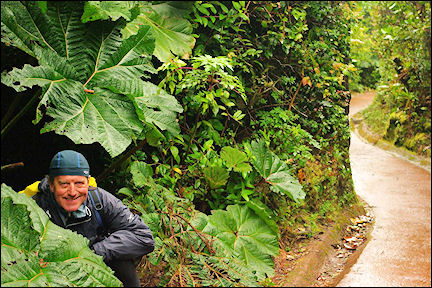
|
Bicycling in Costa Rica, from the Caribbean to the Pacific coast through landscapes with hundreds of different kinds of animals and plants; crossing volcano slopes, through rain forests full of outsized houseplants, along mangrove woods and beaches with palm trees. Passing villages and towns with friendly people, restaurants and hotels in all kinds and sizes. It's warm, but not too dry.
Travelogue & photos: Pieter Parmentier
San José is not a very beautiful city and rather unsuited for biking, but here is where my plane arrives, after a trip of almost 24 hours, in the centrally located capital of Costa Rica. The weather is wonderful in San José: clouded and 25 degrees centigrade. The weather will remain like this: rain, wind, sometimes bright sunshine and almost never cold, perfect for bicycling.
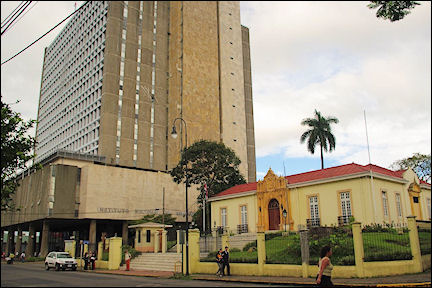
|
I hardly notice that San José lies at a 1,200 meters altitude, but I am made aware that the President of China is visiting. Every cop in the country has been called to the capital to guard it, so we can't go everywhere.
The museums are closed because it's Monday, so that would have been impossible anyway, but some streets are also closed off. No problem, we're here mainly to acclimatise.
Tortuguero
Hemmed in between river and ocean
Our bicycles have survived the flight and are put back together in the basement of our hotel. The rest of our luggage is here, too, so there is nothing to keep us from having breakfast early and leave. The travel agency gave us a booklet with bicycle routes, which we will often use.
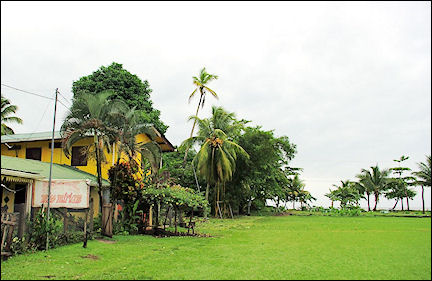
|
We want to visit the Caribbean coast first. Where the road ends, we park our bikes at a bus station and take a boat taxi to Tortuguero. There is over 100 mm rain today. That'll keep the country green!
Tortuguero, hemmed in between river and ocean, is hard to get to and therefore interesting for us and for the many backpackers we encounter. It is located on the edge of a national park with the same name. Tortuguero means turtle village and it is known for its three species of endangered sea turtles who lay their eggs on the beach here.
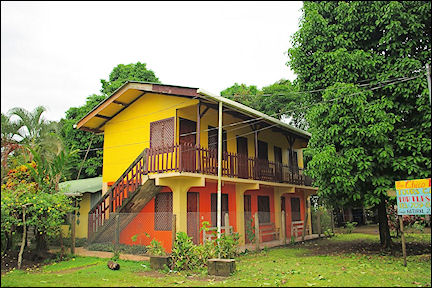
|
Tortuguero is an odd place with a 1960s atmosphere; it has a matching spaced-out guy, sleeping in the mud. Miss Miriam's hotel is wonderful, even though we have to hold on to our sheets at night because of the strong wind.
Many hotels, restaurants, churches and houses don't have glass, only screens in their windows. We call our first accomodation "our little screen house".
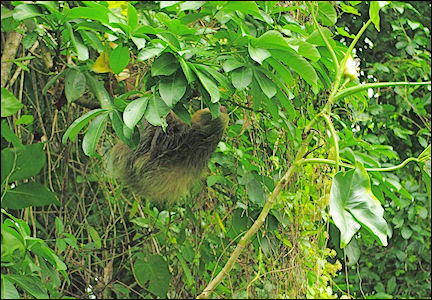
|
The next morning we let ourselves be talked into taking a canoe trip in the surrounding rainforest. It is a wonderful experience, both because of the incredible amount of bio mass and the sturdy Nicaraguan who is too proud to let us row a bit also. He knows a lot about the plants and animals of this region.
Among others, he points out a Jesus Christ iguana, which seems to walk on water.
Arenal
The most active volcano in Costa Rica
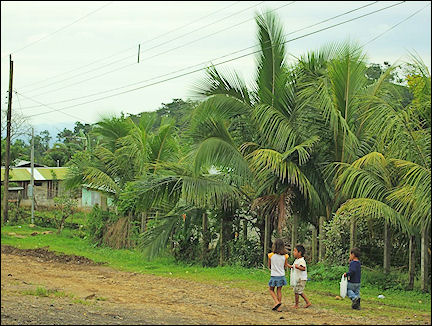
|
The same day we travel back to civilization, because we are a bit in a hurry. That won't stop until we have reached our "ocean to ocean" goal: bicycling from the Caribbean Sea to the Pacific. Until Aguas Zarcas, half way the central plateau in Costa Rica, we bicycle on rather busy asphalt roads.
It's not always clear which way we should go, because of the lack of signposts. On the way to Sarapiqui the Poás volcano (2,700 meters) beckons us. I can hardly wait to climb my first real mountain in Central America, but it would be insane to do it on this first day of bicycling. That is the right decision, because it turns out that after two weeks we can bicycle to the top (almost) at leisure.
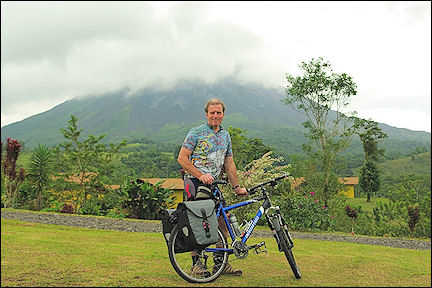
|
We get our first view of the supposedly most active volcano in Costa Rica: Arenal. We soon see that our plan to climb it at night is not feasable because of the lava fireworks it spits out.
The weather is still off due to the tropical storm we just missed. The television news shows images of flooded cities in the north-western part of the country.
Lake Arenal and its surroundings remind us strongly of Switzerland and to our amazement we see a Swiss settlement exactly at the moment we think we've bicycled enough for one day. It's complete with chalets, church and cog railway. It turns out to be a wonderful hotel where we can also have our laundry done. The next morning it turns out that my biking computer is also very clean. My mistake: I left it in the pocket of my bicycle shirt. Unfortunately, it means that from now on we don't know how far we've bicycled and at which altitude we are, which makes it harder to follow our route description.
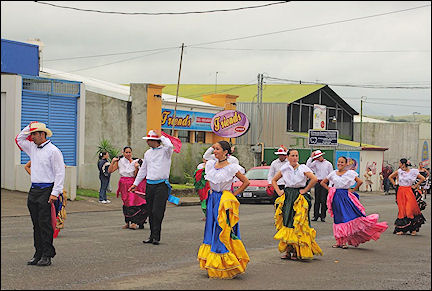
|
Tilaran, south of Lake Arenal, is Costa Rica's "storm city". From November to April there are strong winds and they are extra strong on the day we arrive. The recommended hotel and its American owners compensate for a lot, though. They are warm-hearted and helpful, but seems to be bothered by the wind themselves, too.
But the music festival takes place, anyway: the participating Ticos and Ticas (as the Costaricans call themselves) are used to this weather.
Gulf of Nicoya
Everything blurps, twitters, whistles, roars, chirps and gurgles
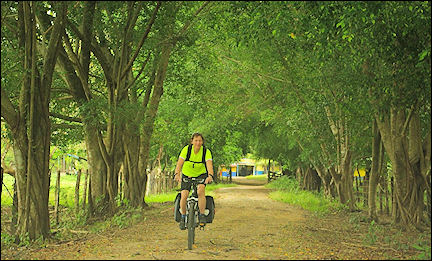
|
The next day the wind is still stormy and we have a leg of highway ahead of us. So we get a taxi van. It's weird how fifty kilometers farther the weather is completely different.
Still on the same day we bicycle in a sultry climate on half-paved, but accessible roads through a park-like landscape to our next surprise. One of the best things of this trip is the variation. Every day is completely different.
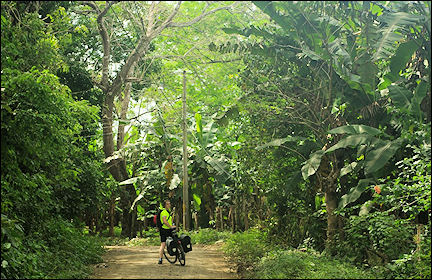
|
We descend amidst a lovely landscape to the Gulf of Nicoya, where everything blurps, twitters, whistles, roars, chirps and gurgles. This last sound makes us thirsty, so when we arrive, tired but satisfied, we sit down at the bar of the Ensenada Lodge in Abangares to take in all this beauty with a drink.
Europeans have built a paradise here on a hacienda of 350 hectare.
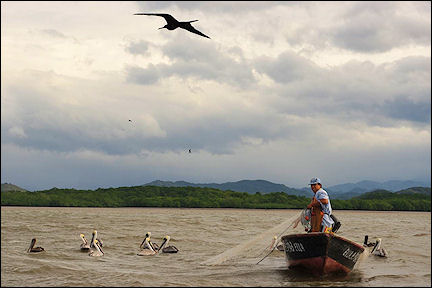
|
We are assigned a "screen house" by the Italian owners. It's roomy, with two double beds and a single one. You won't hear us complain. The food is delicious, the view great, service is friendly and we think we deserve an extra day here.
An English couple takes us to a mountain peak to see the sunset. It's remarkable how people think it's fun or interesting to be friendly with us (as bikers?) and how we seem to enjoy it. It probably helps that we are friendly ourselves ("Hola!" "Buenos dias").
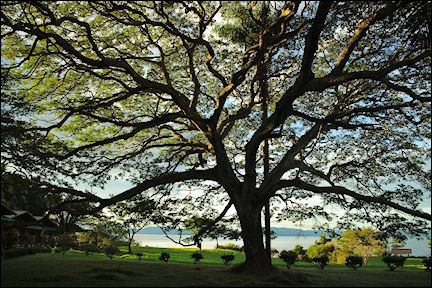
|
It doesn't seem terrible to spend another day in this place. A couple of Dutch tourists invite us to join them on their boating trip. We pass on their tractor, horse and massage activities, though.
They are nice people and we see rare plants and animals, like white-tailed eagles, frigatebirds, pelicans, sloths, howler monkeys, alligators and hummingbirds.
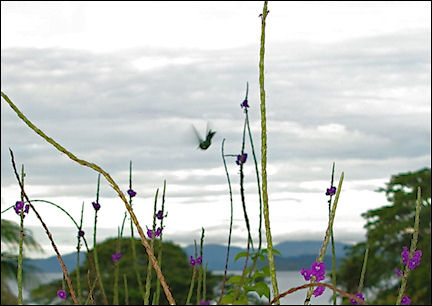
|
For me, the highlight (in this category) of the trip is a fluorescent green hummingbird which is only three centimeters long. Even when I hear later that Costa Rica is home to over a hundred species of hummingbird, it still remains a magical encounter.
Samara
Palm beach, straight from the travel agency's brochure
Even though we would enjoy a longer stay at the Gulf of Nicoya, we want to continue on. At 7 AM we get on our bikes for a beautiful but extremely tough leg over hills that turn out to be mountains with 20% increases. It is the heaviest leg of the whole trip and we get close to our physical limits. I get the idea to cut part of the route as it is described in our booklet.
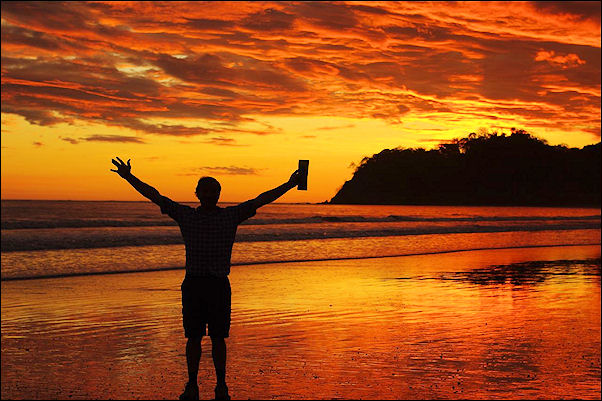
Later it becomes clear that we won't reach Samara by our second ocean - the Pacific - before dark. So we stick out our thumbs to the first passing car.
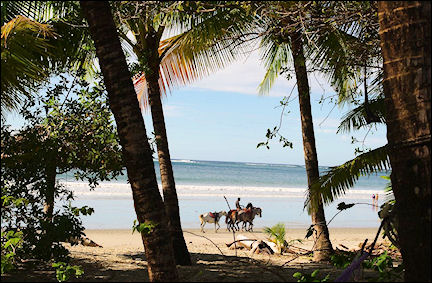
|
The Italian-German couple is willing to take us to their hotel, with our bikes and luggage, in their little rental car. We have found transportation for the last ten kilometers.
Maybe the exhaustion makes us euphoric when we arrive, but the hotel, on a palm beach like you see in travel agency's brochures, trumps everything. We could spend an extra day here, too, we think immediately. And indeed, we can: a stroll on the beach, a bite at a good restaurant, a good conversation with our saviors, we can handle that.
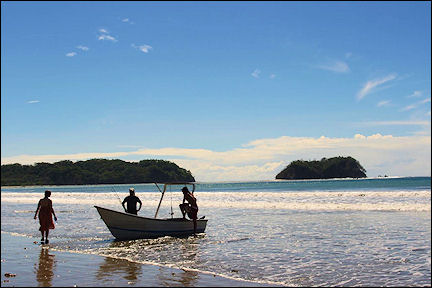
|
Yesterday proved in any case that my travel companion can bicycle 90 km with 15 kilos of luggage, in the burning sun over steep slopes, without falling of her bike. It was a close shave, but after only one day of rest we can continue on our trip.
Now we want to climb a volcano and see nature parks, archeological sites and museums.
Grecia
A city with at least a hundred car dealerships
We bicycle back to the east along a different route. The idea is to cross the Gulf of Nicoya at Puntarenas. This route is much more level. We spend the night in a brand new lodge. During dinner in one of the hundreds of restaurants (sodas) we see on our way, we come up with a nice plan for the next leg.
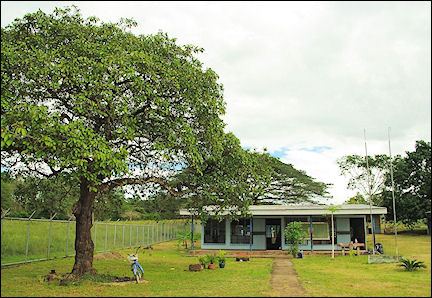
|
We want to get up early, bicycle to the ferry and if possible take the bus to Grecia that same afternoon. The Pan-American Highway from Puntarenas to Grecia doesn't sound attractive for bicycling. That turns out to be true.
The local bus takes us and our bicycles to where we wanted to arrive and we bicycle the last leg uphill to Costa Rica's "car island" (we saw over a hundred car dealerships in this city), called Grecia. We made a mistake planning this leg, we won't arrive before dark, which makes bicycling extra exciting.
The hotel is exceptionally bad. No friendly reception, expensive and we sleep in a "broom closet" (no windows).
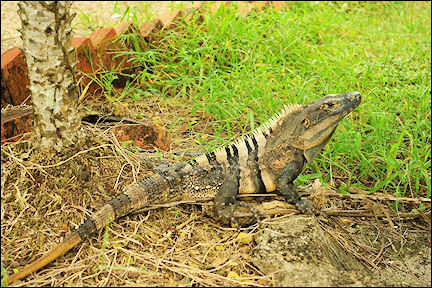
|
But the restaurant we find is excellent. You can find good food almost everywhere in this country. There's a choice of rice with beans or beans with rice (joke!). This is the standard breakfast, lunch and dinner, unless you want something else.
Usually there is excellent fish (tilapia, trout, bass) and meat or chicken with carrots, broccoli, rice with black beans and heaps of fruit. The food is often deliciously spiced in Caribbean fashion and if you ask nicely you get a bottle of good Chilean or Argentinean wine with it. Our knowledge of Spanish is unfortunately very limited and most Ticos don't speak English, but we usually get what we thought we ordered.
Poasito
Bicycling to the top of the Poás volcano
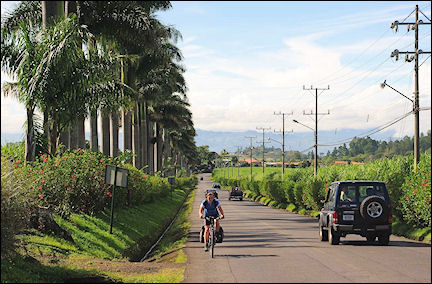
|
Grecia doesn't tempt us to stay longer, though the large church with the usual square park in front is nice. We are getting close to the Poás volcano, which we alredy saw on our way to Arenal. But we have to work hard to get there: climb to 2,000 meters.
It's a pretty route between coffee plantations (with coffee shops) and we take it easy. Also, by now we're in good shape. Bicycling is much easier now than it was during the first week. We notice that we don't get altitude sickness, which usually causes problems on mountain legs. Acclimatising is apparently the key to prevention.
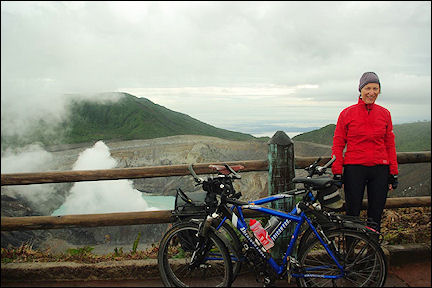
|
In Poasito we find a wonderful hotel once again. We are a little worried about tomorrow, because our challenge - now obscured by clouds - will be the Volcan Poás, 2,700 meters high.
We get up earlier than usual, because we read that in the course of the day, the volcano will be veiled in haze, so if you want to see anything at all, you have to be early. At 6:30 AM, before breakfast, we are on our bikes, without luggage, thinking it will take us two hours to bridge the last 700 meters.
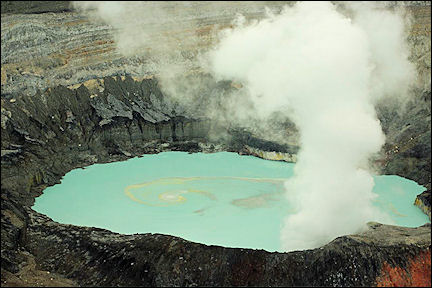
|
At a quarter to eight we're already at the gate of Poas Volcano National Park. It fortunately opens exactly at eight. Quickly we proceed to the edge of the crater. We are lucky: the first twenty minutes we have a great view and only then the visibility gets minimal. We take dozens of pictures.
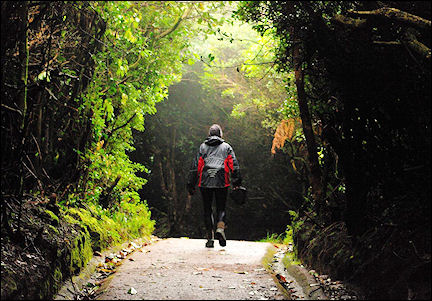
|
It's a strange pandemonium beneath us, with a sulphur lake and sulphur vapors, but it's even weirder that you bicycle at first along green meadows with black-and-white cows, only to arrive in an impenetrable jungle later.
In Europe the meadows are higher up on the mountain and you certainly won't find vegetation at 2,700 meters.
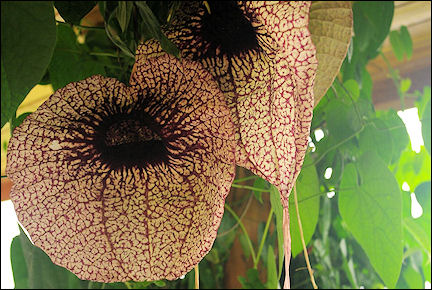
|
With pain in our hearts we leave this gorgeous spot with its friendly hotel, to bicycle completely happy to San José. From there we want to spend our last week bicycling west of the city, as a kind of dessert.
San José
Torrential rains flush out the road
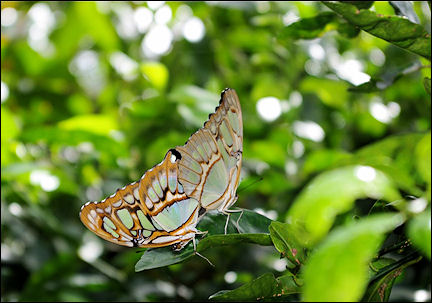
|
Again we decide to take a cab out of the capital with its 330,000 inhabitants. It wasn't fun at all to ride our bikes into the city. Traffic around San José isn't so much dangerous as breathtaking. No sooner than we've left the city, a heavy fog makes it necessary to feel our way.
Our driver often has to ask for directions, the visibility is less than twenty meters.
It is a tense adventure and we don't feel like bicycling the rest of the route as planned. We ask the driver to take us to the Guayabo Lodge in Santa Cruz de Turrialba. We are lucky again. When the clouds disappear, there are beautiful views and wonderful bike paths around a wonderful hotel with a friendly and helpful staff.
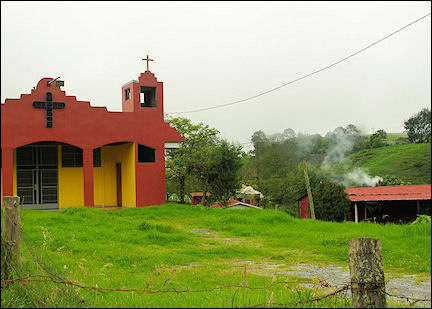
|
The owners, a Costarican-Dutch couple, have built a paradise here in only a few years. He was the long-time director of a nearby agrarian research and educational center and is more than willing to give us a tour - that same afternoon - of its gardens.
The fog of this morning has made room for continuous rain, but that doesn't make the tour less interesting (but wet).
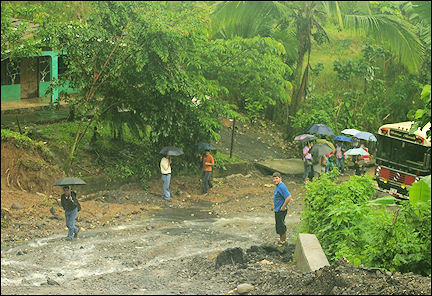
|
The weather isn't any better the next day, so we won't bicycle up the Turrialba volcano or visit the butterfly garden. Instead we visit Guayabo, Costa Rica's most important archeological site. This car trip is also tense.
Torrential rains have damaged the roads here and there. By now we are used to missing pieces of road and usually there are warning signs.
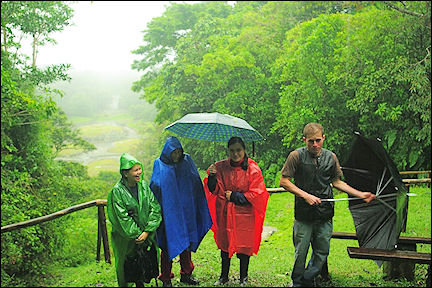
|
But today it's different: a large part of the road has subsided, so bus drivers are forced to let their passengers walk. Our 4x4 can fortunately circumvent the gap. Later we get a tour with an enthousiastic guide to the founddations of the 2,000 years old city of Guayabo.
Twenty per cent of Guayabo has been reconquered on the forest in the last couple of decades. It will be hard to uncover more: as soon as you turn your back, everything is overgrown again.
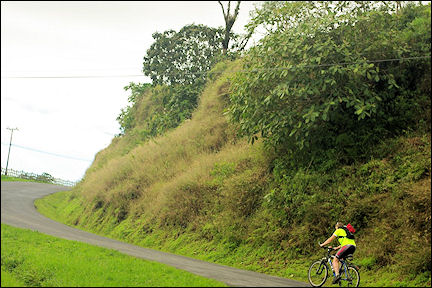
|
We are running out of time, our trip is almost over. We hope we'll have good weather on our last day of bicycling and we do.
Our bike ride back to the capital begins with good weather and the surroundings are beautiful. Okay, it's steep quite often, sometimes for eight kilometers, but we feel super strong after all our exercise.
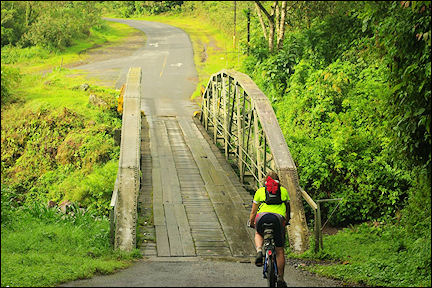
|
This route to the center of San José turns out to be the best one so far, because it only has a few kilometers with heavy traffic. We are back at our base, Hotel Rincón de San José early and are warmly welcomed by the owners, father and son Jos de Haan.
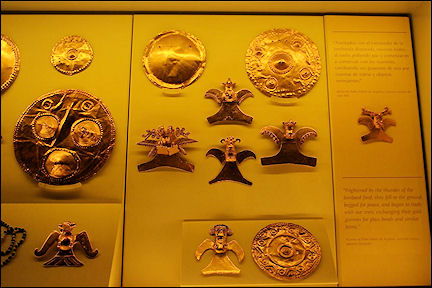
|
We have a last great dinner in "our" outdoor restaurant on the other side of the street. We use the last morning to visit the famous gold museum. And then it's really over.
This is a wonderful country and a great way to explore it. But three weeks is too short: we'll have to come back some time.